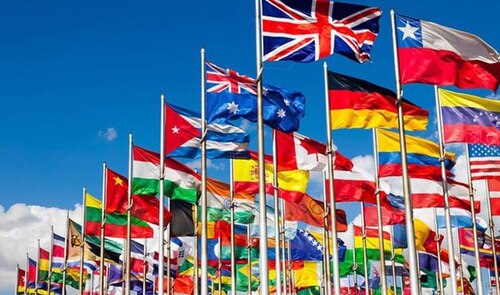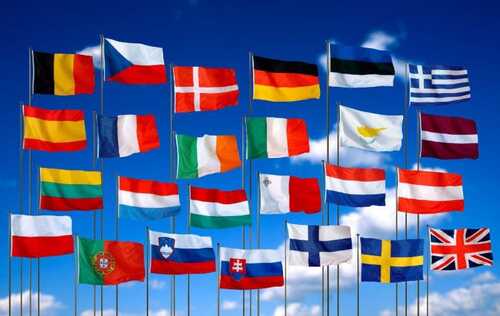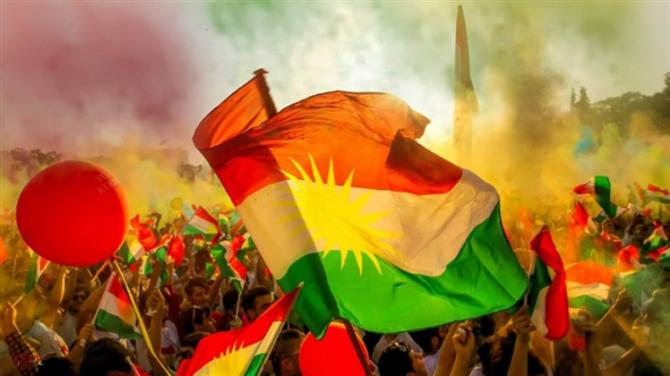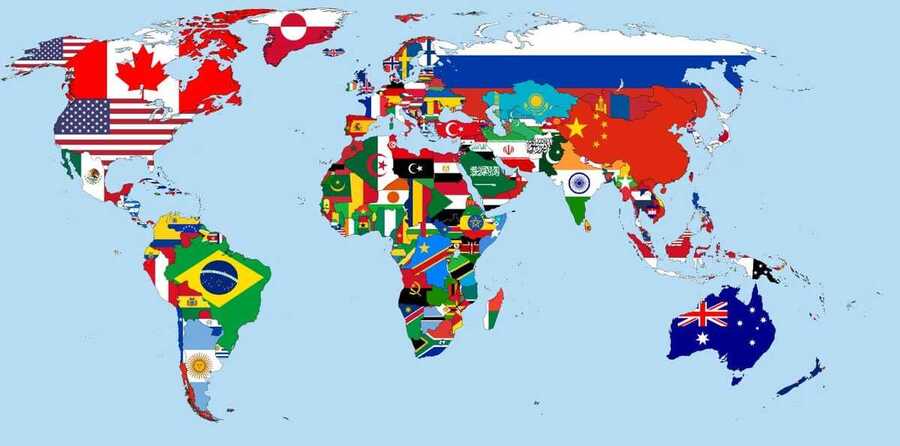The Birth of Flags
Throughout history, various nations, religions, and nation-states have used a flag that reflected their beliefs to distinguish themselves from others. The first official flags were used in China to identify different parts of the army.
The most variable flags have been related to their usage at sea. Ships used their flags for long-distance identification and many other purposes. Some famous flags, such as those of the Netherlands and Spain, were painted specifically for maritime affairs.
Flag and Identity
Just as the "national anthem" in any country represents the "national identity" of that country, the "flag" represents the "national identity" of that country too; the national anthem with its words and the flag with its colors and patterns speak of the identity of a nation.
Like the name of a country, its flag and symbols are very important in identifying any country and reflect the existence, beliefs, ideals, views, ideology, and in some cases, even the history of a nation.
The flag may refer to the geographical, cultural, and even occupational and agricultural situation of a country. The flag is the most important evidence of a country's national identity and symbol in the international community and introduces a nation and its beliefs to the world in a unique and different way.

Flag and State-Nations
With the emergence of nation-states, flags gained a greater role and importance in politics and international affairs. Many independent countries designed their flags according to the ideology and views of the political parties or groups that obtained independence for those countries.
Today, the flag of each country is considered a meaningful symbol that speaks of the identity, history, culture, and philosophy of each country. The flag plays an important role in creating unity among citizens, followers of different religions, and ethnic minorities in a given geography. In some countries, a day of the year is also determined to honor the national flag.
Symbols in Flags
Different symbols are used in flags, for example, the cross is an ancient symbol of Christian cultural domination and following Christianity in a country. The cross is used in the flags of Greece, Denmark, Finland, Iceland, Norway, Sweden, and among many others.
The crescent moon and star are also used in some flags. These two together, the crescent moon and the pentagonal star, have been used as symbols of the religion of "Islam" and the long history of Islamic cultural rule and following the religion in a country. For example, these shapes have been used in the flags of Turkey, Pakistan, Algeria, the Republic of Azerbaijan, Malaysia, and Tunisia.
The five-pointed red star is a symbol of the rule of the Communist Party and is used in the flags of countries like China. They distinguished Chinese communism from Russian communism for their own cultural reasons and changed the color of the stars to yellow in their flag. In the Vietnamese flag, the stars symbolize the five groups of laborers who founded the "socialists" in the country.
The meaning of the stars in the flags of some countries varies; such as "Honduras" and "Philippines" with three stars and "Turkmenistan" with five stars and signs of the proportion of the main states or provinces or regions of those countries.

In some countries, such as Kyrgyzstan, the amount of sunlight has such use; the 40 rays in the Kyrgyz flag symbolize the country's 40 qiblas and 40 heroes.
In the flags of some countries, the number of "stripes" on the flags has a special reason. For example, the 14 red and white stripes on the Malaysian flag represent the 14 provinces or states of the federation. In the Greek flag, nine white and blue stripes refer to the nine of the Greek cries for "Freedom or Death" that was said throughout the country's war for independence.
The occupational or agricultural symbols on the flags refer to the occupation or agriculture or are intended to refer to the agricultural class of the community. For instance, these symbols are found in the flags of Burma and Angola.
The images of plants in the flags represent the specific plants of these countries. The Lebanese flag features the Cedrous tree and the Canadian flag features the Acer leaf.
Images of animals are also a sign of people's religious beliefs or desires about animals. The lion in the Sri Lankan flag and the dragon in the Bhutanese flag are a few examples. The two-headed black eagle, a symbol of strength and sharpness, was also the flag of the Albanian military in the war with Turkey.
In addition to the above, various other shapes, words, and sentences exist on the flags of some countries; like the sentence on the flag of Saudi Arabia, which is the symbol of Islam in that country. There is also the image of the wheel in the Indian flag, which symbolizes the country's Buddhist faith. The image of a famous temple in the Cambodian flag is another example of the country's religious beliefs.

Colors in Flags
Red symbolizes revolution, courage, strength, bravery, and similar concepts. For example, some countries that participated in world wars used red color in their flags to honor the sacrifices of their soldiers. Red also symbolizes the courage and sacrifice of a country's soldiers in the fight for independence. This is what the red color in the Armenian flag means. Red in the Vietnamese flag symbolizes a revolution in the country. In some countries, red symbolizes communist beliefs too.
Green symbolizes security, hope, greenery, and peace. Green in Islam means faith and belief in religion and refers to immortality, and it is a symbol of the other world. Green is the classic color of Islam and appears in the flags of Saudi Arabia, Azerbaijan, and Afghanistan. The flags of Jamaica and Uzbekistan also mention the greenery and forests of those countries.
White in the flags of most countries, such as Uzbekistan and India, means peace. But in others, it has other meanings. In the Finnish flag, it refers to snow in winter, and in the Canadian flag, it refers to the snowy areas of the north of the country. In the flag of Tajikistan, the symbol of the country's important occupation is cotton. White in the Indonesian flag means the soul, which is the opposite of red, which refers to the body. The white cross on the Greek flag symbolizes the purity of the Greek War of Independence.

Kurdistan Flag
As the largest stateless nation in the Middle East, the Kurds have their own official flag.
The Kurdistan flag, which consists of three colors and a sun with 21 rays in the middle, along with other national symbols such as the national anthem Ay Raqib and Peshmerga, is considered a symbol of Kurdish national identity. It is officially recognized by most political forces and parties in the four parts of Kurdistan and is raised on official occasions.
The national motto of the Kurdistan flag is the golden sun. This sun has 21 equal rays; some believe it represents March 21, the beginning of the Kurdish year, and some see it as a symbol of the 21 Median tribes that made a treaty together and established the Median Empire.
Meaning of Colors in the Kurdistan Flag
The red color in the Kurdistan flag means revolution, blood in the war against enemies, courage, strength, and equality; Green means greenery, prosperity, and protection, and white means peace, tranquility, and ceasefire.

Kurdistan Flag Throughout History
During the Batlis uprising in 1914, the Kurdistan flag was made of gold cloth and contained a verse from the Qur'an.
The Kurdistan flag was raised on the British political officer's building during the rule of Sheikh Mahmoud in 1919, which consisted of a red moon and a green surface.
The Kurdistan flag was hoisted during the revolution of Simko Khan Shikak in 1922 and was written Free Kurdistan on it.
During the Sheikh Saeed Piran Revolution in 1925, he led his revolution with a green flag with a sun in the middle.
During the Komalay Hiwa (Hope Association) in 1937, they had a flag and members of this society had to take an oath with the Qur'an, a dagger, and that flag.
The Kurdistan Freedom Party was founded in 1938 and its flag consisted of two daggers and thirty stars.
During the establishment of the Kurdistan Republic on January 22, 2646 (1946), Kurdish year, on the occasion of the removal of the last institutions and remains of the monarchy by the Peshmerga forces of the Kurdistan Republic, the municipality of Mahabad, the Kurdistan flag was officially hoisted.
Currently, the Kurdistan Regional Parliament, according to Decision No. 26 of 11/11/1999, which originated from Law No. 14 of 1991, the shape of the flag, measurements, and the method of hoisting have been determined.
In 2009, the Kurdistan Regional Government (KRG) Parliament declared December 17 as Kurdistan Flag Day, which coincides with the raising of the Kurdistan flag on the Mahabad Municipality building on December 17, 1945, by the Kurdistan Republic.









